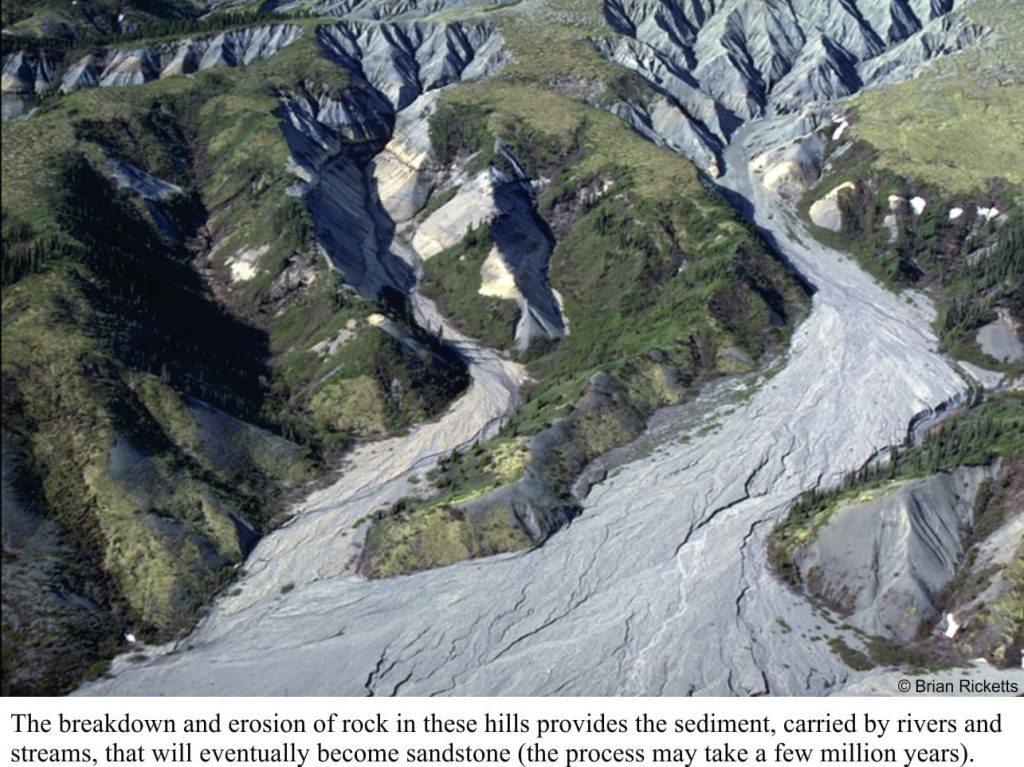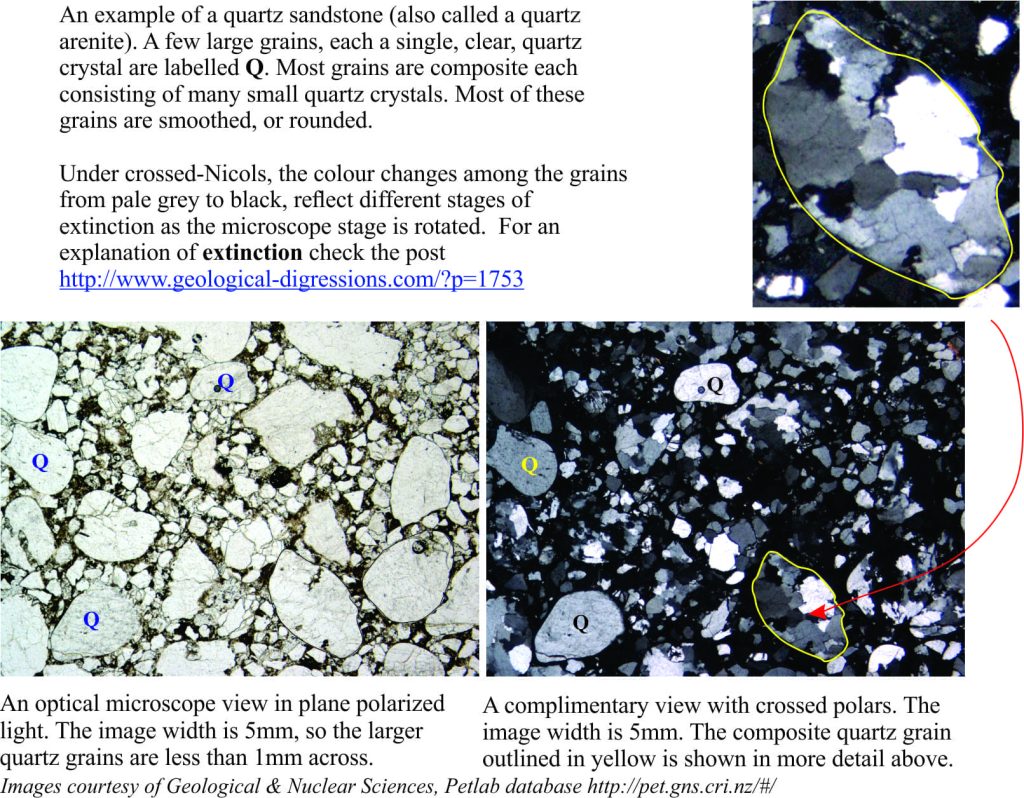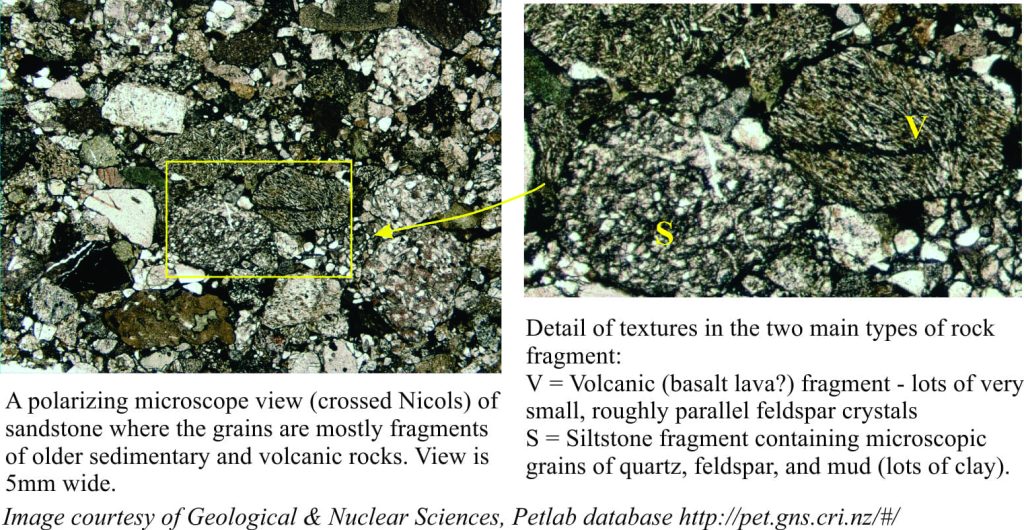What do you think of this analogy; sandstone, and a pile of garbage? I jest, of course. Garbage is no laughing matter – it has become a defining environmental issue of global import. Sandstones too are not to be sneered at.
Your pile of refuse will consist of the flotsam and jetsam of a lifestyle – things you no longer need or want, things acquired over time from any number of localities, some of which may be very far away. Garbage anthropology is a thing. Enlightened folk examine piles of old rubbish because they provide data that allows them to decipher lifestyles and cultural norms.
Sandstone is a sedimentary rock made up of a collection of grains; these too accumulated over time and could have been derived from sources close by or very far afield. Grains of sand consist of many different materials; individual grains may be single mineral crystals, crystal aggregates, or bits of old rock. In fact, the granules making up most sandstones were derived by erosion of some older, pre-existing rock – they are, by analogy, the jetsam of older rocks that over geological periods of time, have been exposed to weather and gravity, and moved by rivers, wind, glaciers, and ocean currents. Equally enlightened folk (sedimentologists) study sand grains (there may also be fossils), asking questions like: where did they come from (where and what was the parent rock?), when and how did they arrive at their destination, and have they changed in any appreciable way during their journey? Like the crystals making up igneous rocks, sand grains tell a story. Some of the images that follow help to illustrate how we unravel these tales.
The first two thin sections show a sandstone made up almost entirely of quartz grains. A few grains are single, clear crystals (labelled Q), but most grains consist of many small quartz crystals seemingly welded together into a composite. If we are to determine the origin of these grains, we need to know the kinds of rocks that have an abundance of quartz. We know a fair bit about the mineral composition of different kinds of rocks, and this knowledge allows us to narrow the search for suitable candidates. In our example, we would not choose basalt, or gabbro (both igneous rocks) as suitable source candidates because they generally have little or no quartz. However, there are three rock types that might fit the bill: rhyolite (a volcanic rock), granite (an igneous intrusive rock), and certain metamorphic rocks.
Rhyolites contain modest amounts of quartz as single crystals, but in granites and metamorphic rocks, quartz abounds. Our experience also shows that metamorphic rocks are good candidates for the kind of grains we see in this example – composite quartz grains (have a look at some of the posts linked below for descriptions of the different kinds of quartz). Rhyolite does not have composite grains so we can exclude this as a possible source. The mineral feldspar is also common in these rocks (along with a few darker minerals like pyroxene, mica and hornblende), and yet none of these are present in our sample.
If we invoke either metamorphic or granitic rocks as possible sources for our quartz sandstone (metamorphic grains seem to dominate), then we also need to explain the absence of these other minerals. One clue to evaluate this problem lies in the shape of the grains. When minerals are eroded from a parent rock, they are commonly jagged and sharp-edged for two reasons: growing crystals normally have sharp edges and well-defined faces (like the facets of some precious gems), or they are broken during their removal from rock. These angular grains are tumbled, jostled and ground together as they are moved by rivers, and in the process, have most of their sharp edges smoothed. Minerals like feldspar are easily broken and abraded as they are transported; quartz on the other hand is relatively hard, and does not break easily. Thus, the processes involved in moving grains of sand from one place to another, will preferentially remove those minerals that are more easily broken and smoothed.
Therefore, it seems likely that the sand in this example has travelled far from its original (mostly) metamorphic source rock. The softer fragments and minerals were preferentially removed en route, leaving a pure quartz sand.
The second example tells quite a different story. Individual grains in this sandstone are made up of older sedimentary and volcanic rock fragments, that we can identify as siltstone and basalt lava. Volcanic fragments like these are easily identified because the myriad, microscopic feldspar crystals (within the grains) are characteristic of once-flowing lava (a previous post shows the same kind of texture in a basalt flow). We know from experiments and observations (particularly in rivers) that granular fragments like these are relatively soft compared with quartz; they do not survive as long when subjected to the rigours of river flow, breaking down into progressively smaller grains. Thus, we can infer that the grains in this sandstone didn’t travel far from their source (old sedimentary and volcanic rocks), unlike the quartz grains in the previous example.
When geologists identify grains in sandstone (and other kinds of sedimentary rock), they are rewarded with data that allows them to make sensible interpretations about ancient landscapes, the rivers that flowed there, where ancient shorelines were located, and even ancient climates. If we are lucky, we will actually locate the candidates for the original source rocks, but not finding them is equally rewarding because we can now pose such questions as, were the original metamorphic rocks or basalt flows completely removed by erosion, or were these ancient parents moved to some other distant shore by tectonic forces? Microscope identification of sandstone grains has the power to inform or refute many hypotheses of the ancient earth. There are still tales for the telling.
Some other useful links
The mineralogy of sandstones: Quartz grains
The mineralogy of sandstones: Feldspar grains
The mineralogy of sandstones: lithic fragments
Describing sedimentary rocks; some basics
Analysis of sediment grain size distributions




















